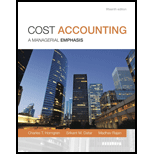
Concept explainers
Material-cost variances, use of variances for performance evaluation. Katharine Johnson is the owner of Best Bikes, a company that produces high-quality cross-country bicycles. Best Bikes participates in a supply chain that consists of suppliers, manufacturers, distributors, and elite bicycle shops. For several years Best Bikes has purchased titanium from suppliers in the supply chain. Best Bikes uses titanium for the bicycle frames because it is stronger and lighter than other metals and therefore increases the quality of the bicycle. Earlier this year, Best Bikes hired Michael Bentfield, a recent graduate from State University, as purchasing manager. Michael believed that he could reduce costs if he purchased titanium from an online marketplace at a lower price.
Best Bikes established the following standards based upon the company’s experience with previous suppliers. The standards are as follows:
| Cost of titanium | $18 per pound |
| Titanium used per bicycle | 8 lbs. |
Actual results for the first month using the online supplier of titanium are as follows:
| Bicycles produced | 400 |
| Titanium purchased | 5,200 lb. for $88,400 |
| Titanium used in production | 4,700 lb. |
- 1. Compute the direct materials price and efficiency variances.
Required
- 2. What factors can explain the variances identified in requirement 1? Could any other variances be affected?
- 3. Was switching suppliers a good idea for Best Bikes? Explain why or why not.
- 4. Should Michael Bentfield’s performance evaluation be based solely on price variances? Should the production manager’s evaluation be based solely on efficiency variances? Why is it important for Katharine Johnson to understand the causes of a variance before she evaluates performance?
- 5. Other than performance evaluation what reasons are there for calculating variances?
- 6. What future problems could result from Best Bikes’ decision to buy a lower quality of titanium from the online marketplace?
Want to see the full answer?
Check out a sample textbook solution
Chapter 7 Solutions
Cost Accounting, Student Value Edition (15th Edition)
- Daley Industries wishes to develop a single predetermined overhead rate. The company's expected annual fixed overhead is $420,000, and its variable overhead cost per machine hour is $3.25. The company's relevant range is from 200,000 to 650,000 machine hours. Daley expects to operate at 520,000 machine hours for the coming year. The plant's theoretical capacity is 850,000 machine hours. The predetermined overhead rate per machine hour should be: a. $3.85 b. $4.06 c. $3.75 d. $4.25arrow_forwardNeed accounting questionarrow_forwardWhat is the total manufacturing costs charged to work in process during Novemberarrow_forward
- Which accounting concept supports recording bad debt expense before accounts are actually uncollectible? a) Full disclosure principle b) Matching principle c) Going concern concept d) Materiality concept need answerarrow_forwardCan you explain the correct approach to solve this financial accounting question?arrow_forwardsubject=general accountingarrow_forward
- Rose Equipment Corporation (LEC) paid $6,800 for direct materials and $11,500 for production workers' wages. Lease payments and utilities on the production facilities amounted to $7,400, while general, selling, and administrative expenses totaled $4,200. The company produced 7,500 units and sold 5,900 units at a price of $7.75 per unit. What was LEC's net income for the first year in operation? Need answerarrow_forwardSolve with explanation and accountingarrow_forward6 PTSarrow_forward
- Principles of Accounting Volume 2AccountingISBN:9781947172609Author:OpenStaxPublisher:OpenStax College
